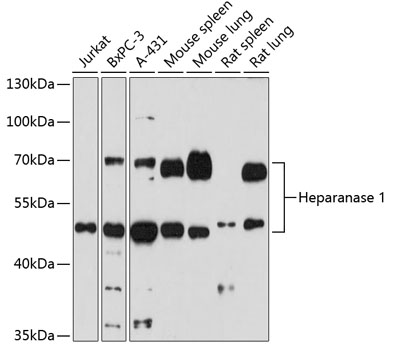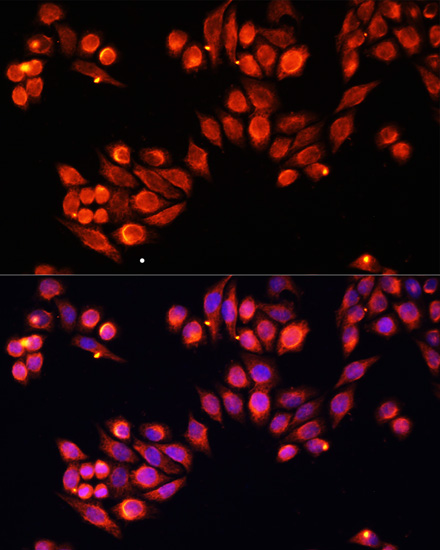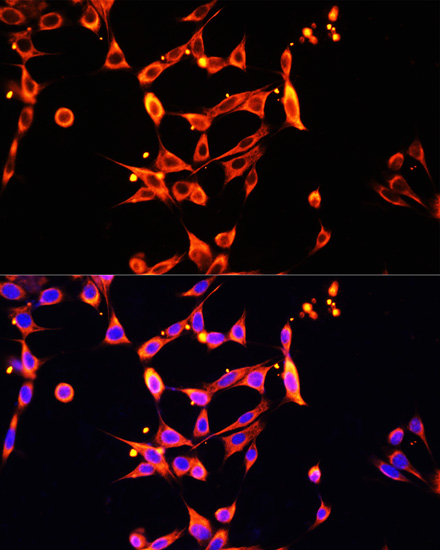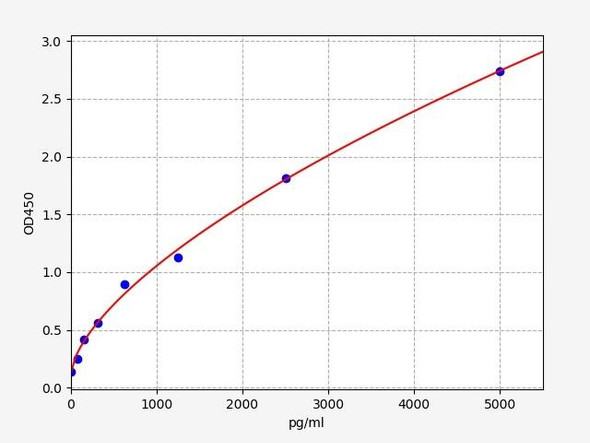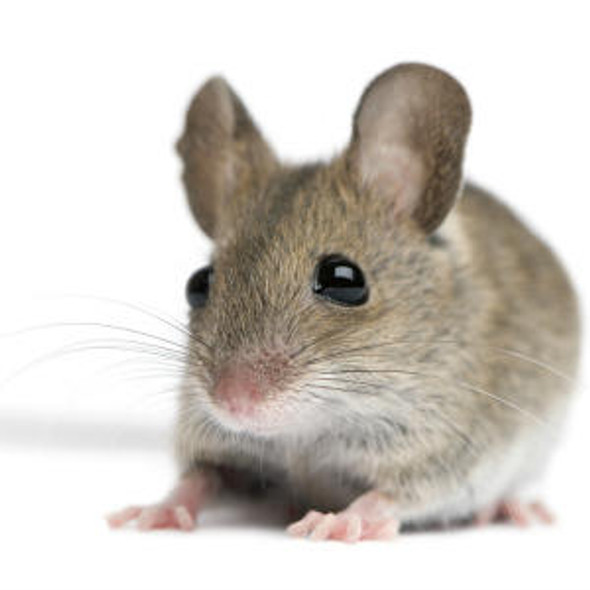Anti-Heparanase 1 Antibody (CAB16488)
- SKU:
- CAB16488
- Product type:
- Antibody
- Reactivity:
- Human
- Mouse
- Rat
- Host Species:
- Rabbit
- Isotype:
- IgG
- Antibody Type:
- Polyclonal Antibody
- Research Area:
- Cell Biology
Description
| Antibody Name: | Anti-Heparanase 1 Antibody |
| Antibody SKU: | CAB16488 |
| Antibody Size: | 20uL, 50uL, 100uL |
| Application: | WB IHC IF |
| Reactivity: | Human, Mouse, Rat |
| Host Species: | Rabbit |
| Immunogen: | Recombinant protein of human Heparanase 1 |
| Application: | WB IHC IF |
| Recommended Dilution: | WB 1:500 - 1:2000 IHC 1:50 - 1:200 IF 1:50 - 1:200 |
| Reactivity: | Human, Mouse, Rat |
| Positive Samples: | Jurkat, BxPC-3, A-431, mouse spleen, mouse lung, rat spleen, rat lung |
| Immunogen: | Recombinant protein of human Heparanase 1 |
| Purification Method: | Affinity purification |
| Storage Buffer: | Store at -20°C. Avoid freeze / thaw cycles. Buffer: PBS with 0.02% sodium azide, 50% glycerol, pH7.3. |
| Isotype: | IgG |
| Sequence: | Email for sequence |
| Gene ID: | 10855 |
| Uniprot: | Q9Y251 |
| Cellular Location: | Lysosome membrane, Nucleus, Peripheral membrane protein, Secreted |
| Calculated MW: | 42kDa/53kDa/54kDa/61kDa |
| Observed MW: | 50kDa/65kDa |
| Synonyms: | HPSE, HPA, HPA1, HPR1, HPSE1, HSE1, heparanase |
| Background: | Heparan sulfate proteoglycans are major components of the basement membrane and extracellular matrix. The protein encoded by this gene is an enzyme that cleaves heparan sulfate proteoglycans to permit cell movement through remodeling of the extracellular matrix. In addition, this cleavage can release bioactive molecules from the extracellular matrix. Several transcript variants encoding different isoforms have been found for this gene. |
| UniProt Protein Function: | HPSE: Endoglycosidase that cleaves heparan sulfate proteoglycans (HSPGs) into heparan sulfate side chains and core proteoglycans. Participates in extracellular matrix (ECM) degradation and remodeling. Selectively cleaves the linkage between a glucuronic acid unit and an N-sulfo glucosamine unit carrying either a 3-O-sulfo or a 6-O-sulfo group. Can also cleave the linkage between a glucuronic acid unit and an N-sulfo glucosamine unit carrying a 2-O-sulfo group, but not linkages between a glucuronic acid unit and a 2-O-sulfated iduronic acid moiety. It is essentially inactive at neutral pH but becomes active under acidic conditions such as during tumor invasion and in inflammatory processes. Facilitates cell migration associated with metastasis, wound healing and inflammation. Enhances shedding of syndecans, and increases endothelial invasion and angiogenesis in myelomas. Acts as procoagulant by increasing the generation of activation factor X in the presence of tissue factor and activation factor VII. Increases cell adhesion to the extacellular matrix (ECM), independent of its enzymatic activity. Induces AKT1/PKB phosphorylation via lipid rafts increasing cell mobility and invasion. Heparin increases this AKT1/PKB activation. Regulates osteogenesis. Enhances angiogenesis through up- regulation of SRC-mediated activation of VEGF. Implicated in hair follicle inner root sheath differentiation and hair homeostasis. Belongs to the glycosyl hydrolase 79 family. |
| UniProt Protein Details: | Protein type:EC 3.2.1.166; Glycan Metabolism - glycosaminoglycan degradation; Hydrolase; Extracellular matrix; Secreted, signal peptide; Secreted Chromosomal Location of Human Ortholog: 4q21.3 Cellular Component: nucleoplasm; lysosomal lumen; intracellular membrane-bound organelle; lysosomal membrane; lysosome; extracellular region; nucleus; lipid raft Molecular Function:protein dimerization activity; syndecan binding; protein binding; beta-glucuronidase activity; heparanase activity Biological Process: positive regulation of hair follicle development; proteoglycan metabolic process; positive regulation of protein kinase B signaling cascade; glycosaminoglycan catabolic process; heparan sulfate proteoglycan catabolic process; positive regulation of blood coagulation; glycosaminoglycan metabolic process; cell-matrix adhesion; positive regulation of osteoblast proliferation; carbohydrate metabolic process; pathogenesis; regulation of hair follicle development |
| NCBI Summary: | Heparan sulfate proteoglycans are major components of the basement membrane and extracellular matrix. The protein encoded by this gene is an enzyme that cleaves heparan sulfate proteoglycans to permit cell movement through remodeling of the extracellular matrix. In addition, this cleavage can release bioactive molecules from the extracellular matrix. Several transcript variants encoding different isoforms have been found for this gene. [provided by RefSeq, Sep 2011] |
| UniProt Code: | Q9Y251 |
| NCBI GenInfo Identifier: | 296434532 |
| NCBI Gene ID: | 10855 |
| NCBI Accession: | Q9Y251.2 |
| UniProt Secondary Accession: | Q9Y251,Q53GE5, Q9UL39, A9JIG7, C7F7I3, C7F7I4, E9PCA9 E9PGR1, |
| UniProt Related Accession: | Q9Y251 |
| Molecular Weight: | 42,791 Da |
| NCBI Full Name: | Heparanase |
| NCBI Synonym Full Names: | heparanase |
| NCBI Official Symbol: | HPSE |
| NCBI Official Synonym Symbols: | HPA; HPA1; HPR1; HSE1; HPSE1 |
| NCBI Protein Information: | heparanase; endo-glucoronidase; heparanase-1 |
| UniProt Protein Name: | Heparanase |
| UniProt Synonym Protein Names: | Endo-glucoronidase; Heparanase-1; Hpa1 |
| Protein Family: | HpaII very short patch repair endonuclease |
| UniProt Gene Name: | HPSE |
| UniProt Entry Name: | HPSE_HUMAN |


